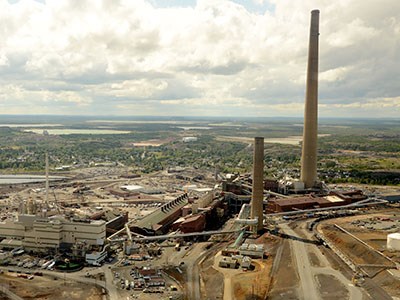Despite rumours to the contrary, Vale said it is still on track to meet its environmental commitments and complete its $1-billion Clean AER project by 2018.
“We’ve looked at some minor adjustments to our capital investment in the next year, but we’re not changing our commitment to completing the project and meeting our environmental commitments in 2018,” said Dave Marshall, director of Vale’s Clean AER project.
AER (pronounced “air”) means “atmospheric emissions reduction.”
Marshall provided a project update to mining industry insiders at a Canadian Institute of Mining event on Jan. 14.
Marshall said Vale has completed around 55 per cent of the work required to finish the ambitious project, which is projected to reduce the Copper Cliff smelter’s sulphur dioxide emissions by 85 per cent from its current levels when the project wraps up.
The project will also reduce greenhouse gas emissions by 40 per cent.
Despite low commodity prices, with nickel trading around US $3.86 per pound in mid-January, Marshall said the project has stayed on schedule.
“We’ve looked at some minor adjustments to our capital investment in the next year, but we’re not changing our commitment to completing the project and meeting our environmental commitments in 2018,” he said.
The biggest expense, said Marshall, is to upgrade the smelter’s converter aisle, which takes molten matte from a large furnace — containing metals and smelters — and removes any iron so only nickel and copper remain.
The process, which uses oxygen to separate the iron from the molten matte, currently releases large amounts of sulphur dioxide, which makes its way up Vale’s iconic superstack.
Despite reducing its sulphur dioxide emissions by 90 per cent since the 1970s, Vale still releases 150,000 tonnes of the toxic gas each year.
The Clean AER project will cut down those emissions to between 20,000 and 25,000 tonnes of sulphur dioxide per year.
To achieve that reduction in emissions, the gas from the aisle converters would be diverted to a new gas cleaning facility — which would cool the gas and remove any nickel, copper and other metals.
Most of the sulphur dioxide left over from that process would go to an existing acid plant and be converted to sulphuric acid.
Once completed, Vale’s complex computer models have predicted the changes would also reduce nearby ground nickel concentration to around 0.16 micrograms per cubic metre. Under current government standards, ground nickel contamination cannot exceed 1 microgram per cubic metre.
Those regulatory standards will change to 0.04 micrograms per cubic metre in 2022.
“When we finish the project there will be additional study required to determine just what is required for us to achieve that new standard,” Marshall said.
Although Vale had originally budgeted $2 billion for the Clean AER project, that commitment was cut in half in 2013 when the company decided to go with a single furnace operation at the Copper Cliff smelter, rather than the original plan for two furnaces.
A second furnace would have also required a second acid plant.
Perhaps the most controversial part of the Clean AER project involves the future of the 1,250-foot superstack, which has defined Sudbury’s skyline for decades.
With fewer sulphur dioxide emissions, the structure would no longer be necessary, and could be replaced by two smaller 450-foot stacks.
While Vale has not yet made a decision regarding the superstack’s future, Marshall said it is possible it could eventually be taken down piece by piece.




